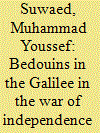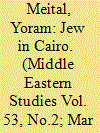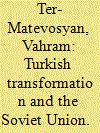|
|
|
Sort Order |
|
|
|
Items / Page
|
|
|
|
|
|
|
| Srl | Item |
| 1 |
ID:
151851


|
|
|
|
|
| Summary/Abstract |
By exploring the hegemonic implications of the Jesuits’ presence in Iraq, this paper examines the geopolitics of desire and cultural dominance that schools may exercise as a representation of institutional power. The Jesuit endeavour in Iraq, including the formation of Baghdad College in the 1930s, is often romanticized and popularized as a true civilizing mission. Baghdad College is often treated as a fetishized commodity that needs to be de-romanticized if it is to be better understood in light of the historical and educational milieu of the time. In what ways can Baghdad College, for instance, be considered a representation of what Ashcroft, Griffiths and Tiffin refer to as ‘the locus classicus of [the] hegemonic process of control’? (2000, p. 63). This paper also argues that the Arab nationalistic movement of Al-Futuwa, which was gaining ground in the first half of the twentieth century, played a crucial role in subverting the hegemonic apparatus exercised by Baghdad College through the use of English and the appropriation of certain worldviews and narratives.
|
|
|
|
|
|
|
|
|
|
|
|
|
|
|
|
| 2 |
ID:
151857


|
|
|
|
|
| Summary/Abstract |
The relations of the Bedouins with the Jewish population during the War of Independence were very complex. The Bedouins were both opponents and friends. Bedouin groups helped the Jews in their struggle against the Palestinian national movement and against the Arab armies like Arab-al-Hib. Before the foundation of the state, these Bedouins had already participated in the protection of the security of the Jewish population. They supplied intelligence on events of the Arab and Palestinian sides, and also fought by the side of the Jews in the War of Independence, but at that time other groups joined the Palestinian national movement and took part in the struggle against the Jewish population, more so after the declaration of the partition plan in the United Nations. Subsequently, Bedouin fighting gangs were established and they joined the Palestinian struggle with the Jewish population.
|
|
|
|
|
|
|
|
|
|
|
|
|
|
|
|
| 3 |
ID:
151849


|
|
|
|
|
| Summary/Abstract |
The aim of this article is to outline the development of Israel's citizenship and immigration policy from its inception to the present, emphasizing the invaluable role of Israel's first Prime Minister, David Ben Gurion. We argue that through a series of decisions pertaining to civic registration, immigration and naturalization of non-Jews, Ben Gurion set the fundamental principles of modern Jewish nationhood: on the one hand, he rejected the option of establishing a civic-Israeli nation, advocating Jewish-ethnic nationhood instead; on the other hand, this was an inclusive Jewish nationhood which incorporated cultural–territorial elements that were based on a secular interpretation of biblical sources. Despite inserting religious elements into Israel's immigration laws over the years, we claim that Ben Gurion's fundamental principles have for the most part remained in effect until today, constituting the key to understanding the nature of Jewish-Israeli nationhood in our times.
|
|
|
|
|
|
|
|
|
|
|
|
|
|
|
|
| 4 |
ID:
151850


|
|
|
|
|
| Summary/Abstract |
This article is the first to expound on Chehata Haroun's personality, his beliefs, and the implications thereof, all of which will be scrutinized within the context of the national and political transformations that convulsed the Land of the Nile, especially its Jewish community, from the late 1940s onwards. For the most part, the emphasis will be on three strands of the activist's critical views of the Middle East. The first is his claim that the Zionist movement and the Arab leadership are jointly responsible for the asphyxiation of Egyptian Jewry. This argument was promulgated in a letter that he addressed to President Gamal ᶜAbd al-Nasser in February 1967. The second strand is that Haroun's Jewishness does not contradict his Egyptian national identity, his uncompromising devotion to communism and humanism, ardent opposition to imperialism, or his identification with the Palestinian cause. The third contention is that the Jewish community and its heritage constitute an indivisible part of the Egyptian social and cultural fabric.
|
|
|
|
|
|
|
|
|
|
|
|
|
|
|
|
| 5 |
ID:
151852


|
|
|
|
|
| Summary/Abstract |
The ‘sacrificial attacks’ in Jerusalem and throughout all of Israel, from July 2014 until August 2015, were the promo of the full-scale knife-attack that started from October 2015 until now. The uniqueness of this wave of terror is its length – over a year – and its use of the old-new ‘white weapons’ which, since October 2015, has included women and children. This research answers how and why these lone-wolf attacks started. The ‘lone-wolf’ attacks, as nicknamed in the Israeli and worldwide press, are, in reality, a continuation of the organized terror activities of the Palestinian liberation organizations especially the Islamic Jihad and Hamas. This is not a popular intifada drawing the masses, nor an armed intifada, but a wave of terror that includes a large number of initiated attacks by known anti-Israel Palestinians connected to terrorist organizations by their past activities or through relatives (prisoners or martyrs) or inspired by the Internet sites and social media. The Palestinian liberation organizations are all protecting al-Aqsa and supporting, without any restrictions, a continuation of the attacks against Israeli targets in Jerusalem and competing with each other.
|
|
|
|
|
|
|
|
|
|
|
|
|
|
|
|
| 6 |
ID:
151854


|
|
|
|
|
| Summary/Abstract |
Literature on the status of the Armenian population during the State of Israel's first decade is virtually nil; a scholarly investigation regarding why Armenians were not drafted into the Israel Defense Forces (IDF), when other small, non-Arab and/or non-Muslim minorities were, has not yet been written. While recognizing the paucity of available documentation, this article will seek to address both of these issues/questions in light of what sources are publicly available as well as in light of the author's own previous research into minority recruitment policies in post-independence Israel. This article will argue that while the Armenians appeared to fit nearly all of the IDF’s criteria for minority recruitment, an Armenian presence in the army ultimately would have provided few tangible advantages to the state from both a domestic and regional perspective. However, due to their non-Arab and non-Muslim identity, the Armenian population was treated as a ‘special minority’ and possessed certain unique privileges denied to other minorities in Israel. This was particularly noticeable in Haifa. However, in other ways, Armenians were treated by state authorities in a very similar manner to the far larger and more distrusted Arab population.
|
|
|
|
|
|
|
|
|
|
|
|
|
|
|
|
| 7 |
ID:
151848


|
|
|
|
|
| Summary/Abstract |
In this article, I contribute to ongoing debates regarding proper conceptions of ‘political Islam’ or ‘Islamism’ by bringing greater attention to the roles that Islamic mysticism, or Sufism, have played in some traditions of Islamist thought and practice. I do so by situating the ‘commanding right and forbidding wrong’ discourse in the wider thought of ʿdeb al-Salam Yassine (d. 2012), founder of the Moroccan Justice and Benevolence Association (Jamaʿat al-ʿAdl wal-Ihsan). This discourse has been interpreted and deployed in various ways by Islamist movements to conceptualize their activist visions, and in the hands of Yassine, we find an understanding which has been thoroughly shaped by Sufism, especially in the role played by spiritual and ethical formation (tarbiya) in cultivating a successful socio-political vanguard. This perspective challenges analytical frameworks which describe Islamist groups primarily as products of modernity or as political ideologies. Additionally, attention to the Sufi-centric aspects of some traditions of Islamism offers a contrast to previous scholarship which has focused almost exclusively on its exoteric scripturalism and fixation on the law. Such insights are crucial when attempting to understand and engage Islamist actors for purposes ranging from cross-cultural understanding to policy formulation.
|
|
|
|
|
|
|
|
|
|
|
|
|
|
|
|
| 8 |
ID:
151853


|
|
|
|
|
| Summary/Abstract |
This article addresses the complex identity of Israel's Palestinian Arab citizens from an atypical perspective: through manifestations of their material culture. The cultural expressions that will be examined are objects from the past and objects that relate to the past, particularly to the rustic Palestinian life profoundly destabilized by the 1948 Arab–Israeli war. These objects, displayed in the homes of some of Israel's Arab citizens, are interpreted by contemplating their design, the design of their environment, their relationship to other objects, and their placement within the domestic sphere. Our study is animated by the desire to sketch a cultural portrait of Palestinian Arab Israelis, as well as by a methodological interest in interpretations based on a socio-architectural reading of objects.
|
|
|
|
|
|
|
|
|
|
|
|
|
|
|
|
| 9 |
ID:
151855


|
|
|
|
|
| Summary/Abstract |
Looking at the relationship between tattooing and its past and present Islamic interpretations, this article presents the case of an old tattooing practice that transformed into a folk belief. Setting aside the antagonistic tension between tattooing as an adorning means and Islamic injunctions prohibiting tattooing, this article assesses the practice by reference to the ways it was recently encapsulated within a narrative of fashion, usage and custom. The study is based on multi-sited ethnographic fieldwork, participant observation and extensive interviews carried out with members of the Arab tribe Hatipogullari, living in five villages and on the hilly ‘arable field’ (Arap Bölgesi) near the town of Siverek, in the south-eastern Turkish province of Şanliurfa.
|
|
|
|
|
|
|
|
|
|
|
|
|
|
|
|
| 10 |
ID:
151856


|
|
|
|
|
| Summary/Abstract |
Being founded in the wake of the First World War, both Turkey and the Soviet Union followed revolutionary modernizing pathways. At the outset, one could trace many similar patterns in their radical modernization paradigms; however, their development models as well as political and social orders were radically distinct, which became more obvious with the passage of time. The paper discusses the external interpretations of Kemalism by observing the Soviet perspectives on the inception and evolution of Kemalism. Paying more attention to diplomatic, geopolitical and economic complexities of the Turkish-Soviet relations, scholars have rarely problematized the Soviet Union perceptions of Turkish ideological transformations. In reality, since the early 1920s, different state institutions, intellectual schools of thought and research in the Soviet Union closely observed the domestic transformations in Turkey by providing valuable insights on the perspective and the implications of the Kemalist transformation. The article also looks at the question of how the incorporation of Soviet perspectives can enrich the historiography and our understanding of Kemalism.
|
|
|
|
|
|
|
|
|
|
|
|
|
|
|
|
|
|
|
|
|